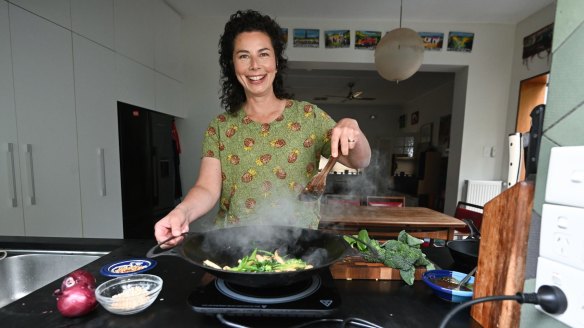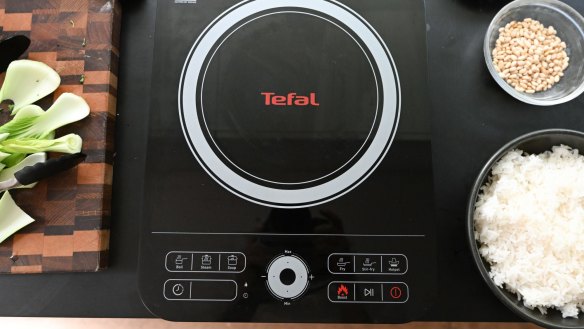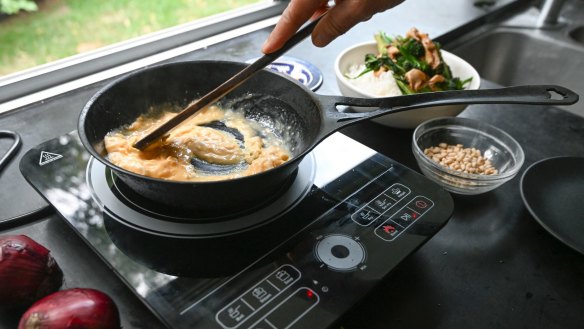Induction v gas: Which cooktop comes out on top in our road test?

The debate is certainly heated. Is it better to cook with gas or shift to electricity-powered induction? And what are the downsides to using a new-fangled induction cooktop?
I'm not going to go as far as Californian chef Andrew Gruel, who recently taped himself to his restaurant's gas cooker as a stunt protest against a pro-electric cooking push. But I am sceptical. Gas feels like cooking to me.
I'm doubtful about moving to induction and relying on the invisible magic of agitating magnetic particles to cook my dinner. I also love my copper pans and I know they won't work on induction.
According to a recent report from Asthma Australia, 48 per cent of Australians cook with gas at home while just 6 per cent use induction. (Almost all of the rest have old-style electric cooktops that use thermal conduction.)
Induction is gaining ground, prompted by concerns about kitchen air quality and carbon emissions. But gas has lots of hold-outs: the same asthma study shows that 71 per cent of people who prefer gas say it's because they like cooking with it. I decide to embark on an old-fashioned cook-off to see if it's time to unpick my preconceptions.
THE TEST
I used a plug-and-play 10-amp Tefal induction cooktop to test boiling, grilling, toasting, wok-cooking, deep-frying and egg cooking.

THE DISHES
Pine nuts
On my trusty gas stove, I've burned pine nuts more often than I've toasted them. Look once and they're a lovely golden brown, look again and they're an acrid black rubble. This seemed like a good test of induction's responsiveness. Because induction goes lower than my smallest gas burner, I was able to slowly and carefully get colour on my pine nuts. A definite win.
Pasta
This started badly. I measured three litres of water into my favourite large pasta pot and set the induction unit to "boil". Nothing happened. After a few futile stabs at the controls, I took the radical step of reading the manual. My small unit only heats pots up to 24-cm diameter. This pot was 26cm. I regarded old faithful with wistful regret then reached for a smaller saucepan.
Now it was action stations! Two litres of water boiled in less than eight minutes – my gas hob took more than 12 minutes – and the water returned swiftly to a rolling boil when I added my fusilli. I set the timer for 10 minutes, after which the heat turned off automatically. It's also worth noting that larger cooktops heat larger pots so I wouldn't necessarily have to ditch old faithful if I made the switch. Tick.
Schnitzel
The evenness and responsiveness of induction made it a cinch to sizzle a schnitzel. The pan heated evenly, meaning the crumb was uniformly golden without the hotspots and pale patches that can occur on a gas burner. Schnitz success!
Stir-fry
This is the stumbling block for many cooks. My flat-bottomed cast-iron wok by Australian brand Solidteknics works on induction but there's no comparison to the powerful licking flames of my gas wok-burner. Traditional wok-cooking relies on direct heat in the base of the wok, and different gradations of heat that creep up the sides.
My broccolini and oyster mushrooms were cooked, got a little colour, and tasted great, but they lacked the "wok hei" (breath of the wok) that turns a colourful sizzle into a true stir-fry. It's not bad, but it is different.
Dumplings
Deep-frying frozen dumplings was easy because you can set whatever's in the pot to heat to a precise temperature. I set a small pot of oil to heat to 160C, waited for the telltale shimmer, carefully dropped in Sichuan pork dumplings, set the timer to five minutes and waited for the beep. When deep-frying on my gas stove, I use a thermometer to calibrate frequent adjustments to the flame. Induction is way easier. Cleaning the inevitable oil spits and splashes is a breeze too.
Rice
This was a qualified success. I cooked a cup of jasmine rice by the absorption method and the rice was incredible: fluffy, evenly cooked and fragrant. The only problem was that there was a layer of rice stuck to the base of the pot.
I tried it again – this time adding the water before the rice and giving it a stir before cooking. Again, the rice was perfect but there was a layer caked on the bottom of the pot. I think this is an illustration of the learning curve required with induction. Dishes don't always work the first (or second) time when cooking with new equipment. I'm confident that with a couple more goes at adjusting the settings, I'd nail it.
Scrambled eggs
I used a low-to-medium setting to scramble two eggs and it was honestly quite relaxing, a little slower than on gas but satisfying and with a great creamy, curdy result.

In favour
Gas
- Can use any pans, while induction requires pans with ferrous bases such as cast iron and steel
- Often cheaper to install
- Uses less electricity
- Flames heat the sides of cooking vessels, making for better wokking
- Flames feel more like cooking
Induction
- Keeps kitchen cooler
- Healthier home environment free from particulate matter associated with gas
- Fewer carbon emissions if using green power
- Can be cheaper to run
- Increased power requirement can be expensive to install in older buildings
- Safety features such as auto-off
- No flames make it less nerve-wracking to cook with kids
WOULD I GO THERE?
Yes, in my next kitchen, I'd be glad to ditch gas.
